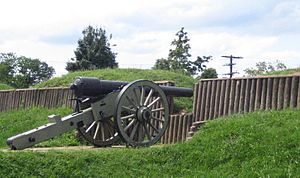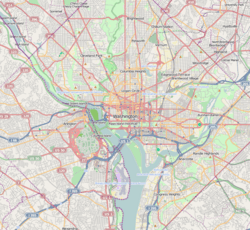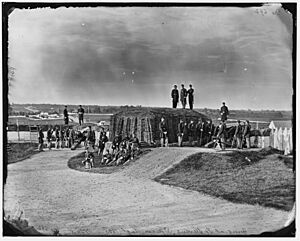Fort Stevens (Washington, D.C.) facts for kids
Fort Stevens was a very important fort built to protect Washington, D.C., during the American Civil War. It was first called Fort Massachusetts. This fort was part of a huge network of defenses that surrounded the capital city.
Contents
Where is Fort Stevens?
Fort Stevens was built in 1861. It was first named "Fort Massachusetts." Later, the Union Army made it bigger. They renamed it "Fort Stevens" to honor Brigadier General Isaac Ingalls Stevens. He was a brave general who died in a battle in 1862.
When it was first built in 1861, the fort was about 168 yards around. It could hold 10 cannons. By 1862, it was much bigger. It stretched 375 yards and had room for 19 cannons.
The fort was very important because it guarded the main road leading into Washington, D.C. from the north. This road was called the Seventh Street Turnpike. By 1864, Fort Stevens was just one part of a huge defense system. This system was 37 miles long! It had 68 forts and was built to protect the capital city. Washington became one of the most protected cities in the world.
Building the Fort
Fort Stevens was part of a big plan to build a ring of defenses around Washington, D.C. After the Union Army lost the First Battle of Bull Run, Congress decided the city needed more protection. Before this, there was only one fort, Fort Washington, far to the south.
In September 1861, Union soldiers took over land owned by a free Black family. This family was Elizabeth Proctor Thomas and her siblings. Their land was perfect for building a fort. The soldiers had to destroy her home, barn, orchard, and garden to build what became Fort Massachusetts.
Elizabeth Thomas often told a story about this time. She said she was watching the soldiers destroy her home, holding her baby and crying. A tall, thin man in black came up to her. He told her, "It is hard, but you shall reap a great reward." Many people believed this man was President Abraham Lincoln.
Elizabeth Thomas had to fight for many years to get paid for her destroyed property. Finally, in 1916, she was given $1,835. This was just a year before she passed away.
The Battle of Fort Stevens
The most famous event at Fort Stevens was a battle in July 1864. A Confederate force led by Major General Jubal Early marched towards Washington, D.C. They had been delayed by another battle.
On July 11 and 12, 1864, Confederate soldiers attacked Fort Stevens. They were delayed because they stopped to steal horses and stayed overnight in nearby towns. In response, Major General George Thomas ordered the local militia to help defend the fort.
On July 11, Confederate sharpshooters (snipers) shot two Union soldiers. But the Union soldiers pushed the Confederates back. The Confederates used a nearby house as their headquarters and a hospital. They also took livestock from local farms. By the evening of July 11, people lined Seventh Street to watch the fighting. Even Secretary of State William Seward watched from his carriage.
The Union Army destroyed five nearby houses. They did this to stop Confederate sharpshooters from using them. The homeowners were allowed to remove their furniture first. But Confederate sharpshooters still used another house nearby to shoot at Union soldiers. The Union soldiers fired at the house, forcing the sharpshooters to leave. That house was later burned down.
Overnight on July 12, the Confederate soldiers retreated. They left behind 101 wounded soldiers. The total number of Confederate casualties is not known. About 50 Union soldiers were killed, wounded, or went missing.
Many stories say that President Abraham Lincoln rode out to the fort on both days to watch the battle. He was even briefly under enemy fire from sharpshooters. On July 12, he was told to take cover, probably by Union Major General Horatio Wright. A famous story says that Oliver Wendell Holmes Jr., who later became a Supreme Court Justice, yelled at Lincoln, "Get down, you fool!" Another story says Elizabeth Thomas, the woman whose land was taken, said this.
This battle is believed to be only the second time in American history that a sitting president was under enemy fire during a war. The first time was President James Madison during the War of 1812. However, a newspaper article from July 13, 1864, mentioned that President Lincoln and Mrs. Lincoln visited the defenses and were greeted by soldiers. It did not mention Lincoln being under fire.
Fort Stevens Today
After the war, the fort was no longer used. Later, a group worked to create a memorial. A stone monument was dedicated on November 7, 1911. In the late 1930s, a group called the Civilian Conservation Corps helped restore parts of the fort.
Today, Fort Stevens is a historic site. It is located near Georgia Avenue in Washington, D.C. The National Park Service now takes care of it as part of the Civil War Defenses of Washington. The remains of 41 Union soldiers who died in the battle are buried nearby at Battleground National Cemetery.
Further up Georgia Avenue, there is a monument to seventeen unknown Confederate soldiers. These soldiers also died at Fort Stevens and are buried in a cemetery there.
Images for kids







